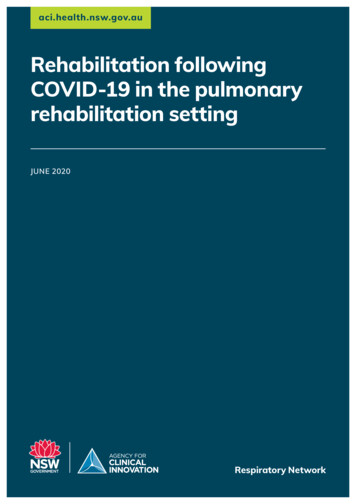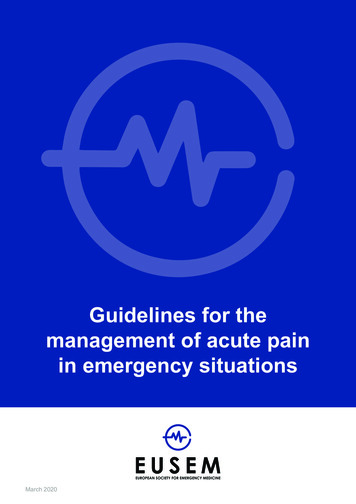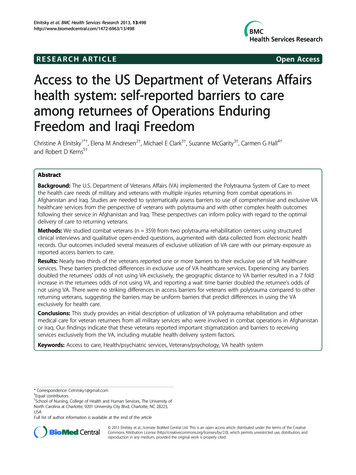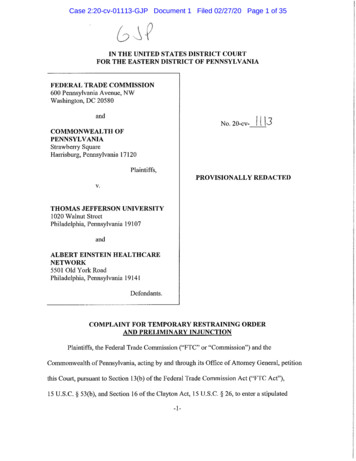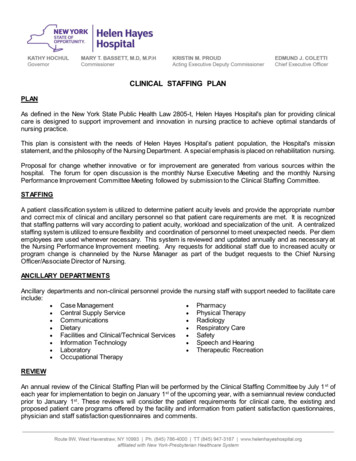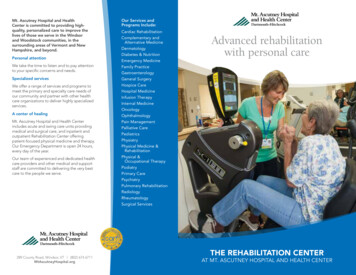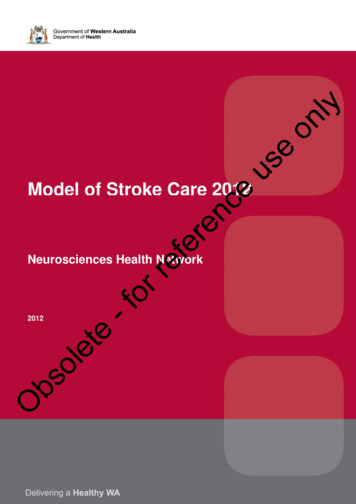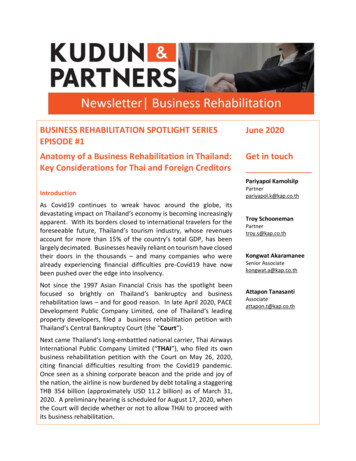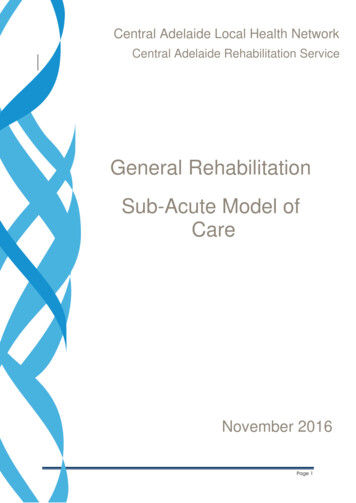
Transcription
Central Adelaide Local Health NetworkCentral Adelaide Rehabilitation ServiceGeneral RehabilitationSub-Acute Model ofCareNovember 2016Page 1
ContentsABBREVIATION LIST . 41. Purpose of Document . 51.1Assumptions . 72. General Rehabilitation . 82.1Objectives . 92.2Governance . 102.3Principles of Care . 103. Model of Care . 123.1Inpatient . .133.1.1 MOC Key Elements . 133.1.2 Specialist Key Elements . 153.1.3 Rehabilitation in the Home (RITH) . 163.2Ambulatory Services. 163.2.1 Day Rehabilitation Service (DRS) . 173.2.2 Outpatient Clinics . 173.3Early Rehabilitation . 183.4Patient Casemix . 183.5Admission Criteria . 183.5.1 Inpatient . 183.5.2 Additional Criteria for Rehabilitation In The Home (RITH). 193.5.3 Day Rehabilitation Service . 193.6 Central Point of Referral . 203.7 Triage & Assessment . 203.8 Discharge Criteria and Pathways . 214. Enablers . 244.1Workforce . 244.2Optimised Rehabilitation Across the Continuum . 254.3Infrastructure and Equipment . 265. Appendicies . 295.1Appendix 1 – Triage Process Pathway . 29Page 2
5.2Appendix 2 - Patient Pathways . 306. References . 31Page 3
ABBREVIATION LISTABIAcquired Brain InjuryBIBrain InjuryBIRUBrain Injury Rehabilitation UnitCALHNCentral Adelaide Local Health NetworkCARSCentral Adelaide Rehabilitation ServiceDRSDay Rehabilitation ServiceHRCHampstead Rehabilitation CentreIDTInterdisciplinary TeamLHNLocal Health NetworkMDTMulti-Disciplinary TeamNDISNational Disability Insurance SchemenRAHNew Royal Adelaide HospitalNTRUNeurotrauma Rehabilitation UnitOWIOrganisation Wide InstructionPHCPrimary Health CareRAHRoyal Adelaide HospitalRITHRehabilitation In The HomeSABIRSSouth Australia Brain Injury Rehabilitation ServiceSASCISSouth Australia Spinal Cord Injury ServiceSCISpinal Cord InjurySDMSubstitute Decision MakerTHICTransforming Health Implementation CommitteeTQEHThe Queen Elizabeth HospitalPage 4
1.Purpose of DocumentThis document outlines a model of care (MOC) for General Rehabilitation Servicesinitially at Hampstead Rehabilitation Centre and following transfer, at The QueenElizabeth Hospital (TQEH), Central Adelaide Local Health Network (CALHN).The MOC describes the objectives, governance and overarching principles of care,the patient cohort, MOC, and enablers.This plan specifically provides details regarding: Service description, profile and service delivery model including operationalperformance targetsPatient flowsWorkforce requirementsClinical and non-clinical support servicesThis document describes a rehabilitation service that is aligned to the strategicpriorities and goals of the Government of South Australia’s Transforming Healthproject and to be a sustainable health service that is: Person and Family CentredSafeEffectiveAccessibleEfficientEquitableAs part of the Single Service Multiple Sites model, this MOC also takes into accountthe integration of services within and across clinical areas of CALHN wherebypatients and Substitute Decision Makers (SDM) are supported to receive prompt,appropriate assessment and care.The MOC underpins the way we provide services across all of our campuses andfocusses on our commitment to care and provision of person and family centredcare. The diagram below (Diagram 1) summarises the operation of our MOC from apatient pathway perspective across the continuum of care incorporating out ofhospital and in-hospital services.In developing this Proposed MOC for General Rehabilitation other documentsrelating to aligned services were considered, namely: Spinal Cord Injury and Brain Injury Clinical Service Plans and Models of Care forthe TQEH Draft Ambulatory Rehabilitation Services – Proposed Model of CarePage 5
Draft MOC for the Neurotrauma Rehabilitation Unit at nRAH Transforming Health MCAG Rehabilitation Services Development Project:Service Components for Optimum Rehabilitation Care in South Australia REPORTFebruary 2016This document is consistent with and aligned in its content to support new models ofcare being developed for inpatient rehabilitation and Ambulatory RehabilitationServices. Transforming Health outlines the need for expanded ambulatory services toallow rehabilitation to occur early in the patient journey and where possible in apatient’s home, stating ‘Care should be delivered in the most appropriate costeffective venue as close to home as safely possible’ Delivering Transforming Health –Our Next Steps 1.It is imperative that all philosophies, processes and implementation plans are alignedin order to develop a self-supporting and sustainable system for rehabilitation.Diagram 1: SA Health Continuum of CareConsistent with this, our commitment is that we will improve the care we deliver toour patients by taking a holistic and comprehensive approach. This approach willaddress direct and indirect services, our workforce and culture improving thecare we deliver to our patients in four significant ways:Page 6
Diagram 2: Commitment to Care Matrix1.1AssumptionsThe development and ongoing use of this MOC is based on a number ofassumptions: The MOC document is a point in time document and as such is intended tobe a living document that will be revisited and updated along theTransforming Health journey and further evaluated post implementation This MOC has been developed based on the current service targets thathave been defined for Central Adelaide Rehabilitation Service (CARS)2. Ongoing transformational processes that are underway across the LocalHealth Network (LHN) may influence future service locations and operations While these assumptions are important to acknowledge, they do not overrideor compromise our overarching MOC principles and our commitment to theTransforming Health journey. For the purposes of consistency in this document the term ‘patient‘ is atoryandothercommunity based services are generally referred to as ‘clients’.Page 7
2.General RehabilitationCARS is recognised as a centre of excellence with national and internationalreputation in the provision of specialist rehabilitation, teaching, research and clinicalservices.CARS provides specialised rehabilitation services across the entire health carecontinuum including rehabilitation for inpatients, outpatients, ambulatory careservices and programs, including Day Rehabilitation Service (DRS) and RehabilitationIn The Home (RITH), as set out in the SA Health Care Plan 2007-2016, State-wideRehabilitation Service Plan 2009-2016 and the SA Health Model of Care for MajorHospitals (2013).The State-wide Burns Rehabilitation Service is integrated within the generalrehabilitation wards and is therefore included in this document. The models of carefor the other state-wide services (SA Spinal Cord Injury Service and SA Brain InjuryRehabilitation Service) are addressed in the MOC documents named above.CARS provides leadership and expertise in the provision of patient-centred, qualityand evidence based rehabilitation programs which include stroke and neurological,amputee, orthopaedic, burns and general reconditioning programs. In line withTransforming Health rehabilitation is evidence based3and best practice is guidedby: Clinical Guidelines for Stroke Management (National Stroke Foundation 2010) Pathway for Stroke Rehabilitation (SA Health, 2014) SA Stroke Service Plan 2009 – 2016 (SA Health, 2009) Model of Amputee Rehabilitation in SA (SA Health, Feb 2012) Model of Care for Orthopaedic Rehabilitation (SA Health, May 2011) Joanna Briggs Institute (JBI) Burns Node recommended Practices. American Burns Association Verification Guidelines 2014 Australian and New Zealand Burns Association (ANZBA) Allied Health ClinicalGuidelines (October 2014) Model of Rehabilitation for Spinal Cord Injury in South Australia, Feb 2012 Model of Rehabilitation for Acquired Brain Injury in South Australia, 2012 Model of Rehabilitation for South Australia, Feb 2012Page 8
Rehabilitation is a component of all medical and surgical care; however certainlevels of impairment mandate specialist rehabilitation care. In certain conditions, forexample Stroke, Amputation, Multi-Trauma, Burns and in certain individual medical,surgical and geriatric cases, specialist rehabilitation care should proceed inpartnership with acute care.It is expected that the commencement of rehabilitation in acute settings features inthe Clinical Service Profiles of these acute services. The patient is appropriate fortransfer to CARS once they are medically stable and are willing and able toundertake a minimum of 3 hours of therapy per day. The patient journey is seamless,with open communication of assessment, goal setting and rehabilitation careplanning through shared documentation and timely clinical handover.CARS works in close collaboration with other directorates across CAHLN to ensureearly identification of patients requiring rehabilitation assessment and consultationservices. Patients identified by clinicians as being appropriate for rehabilitation arereferred to the CARS patient flow coordinator who provides a single point of access.The coordinator arranges the appropriate triage, and the CARS multidisciplinarytriage team assesses and provides consultancy and, where appropriate, facilitatestransfer to rehabilitation services. Close links are maintained with the CALHNHospitals to ensure safe, efficient and effective transition of suitable patients togeneral rehabilitation in-patient services and/or to ambulatory or outpatientrehabilitation programs/clinics/services.Rehabilitation consultants will provide a consultation service and certain proceduralservices in both inpatient and outpatient settings and are responsible for the clinicalmanagement of individual patients within CARS.2.1ObjectivesThe objectives of providing General Rehabilitation at TQEH are as follows. Improve patient care, by: Streamlining care and developing best practice protocols andpathways across care settings Supporting early detection and prevention of complications that mightadversely impact rehabilitation outcomes -conditioning, maintain and improve function while in the hospital,Page 9
thereby potentially reducing length of stay and improving patientoutcomes Cohorting patients to ensure staff have the appropriate skillsets tomanage their complex rehabilitation needs Optimise bed management and the patient journey, by: Providing early specialist rehabilitation assessment, management anddischarge planning Allowing continued treatment of an acute illness in parallel with theprovision of rehabilitation Using ambulatory rehabilitation services optimally to enable earlydischarge Providing early transfer from an acute bed and reducing total lengthof stay2.2GovernancePatients admitted to inpatient rehabilitation services, including RITH, transfer to arehabilitation code for case-mix purposes and are managed by the rehabilitationconsultant. This case-mix coding enables rehabilitation funding to apply from thetime of admission to CARS and a rehabilitation MOC to be provided.2.3Principles of CareThe guiding principles of this model are consistent with the State-wideRehabilitation Service Plan4(2009) and SA Health’s aim to optimise care byproviding the right care, at the right time, in the right place; consistency andequity in access; seamless services; partnerships in service delivery; and byoffering patient a n d f a m i l y centred care that optimises physical recovery,function and psychosocial wellbeing, maximises independence, vocation andlifestyle opportunities.This model operates within a rehabilitation framework. Rehabilitation is “theprocess of assessment, treatment and management with on-going evaluationby which individuals (and their family/carer/SDM) are supported to achieve theirmaximum potential for physical, cognitive, social and psychological function,participation in society and quality of living”5.Page 10
Rehabilitation services will be tailored to the individual and allow for episodic return(i.e. admission after an intervening time period after discharge from the acutefacility) depending upon the nature of the patient’s condition. While the demandfor rehabilitation spans all ages, it increases with age. Older people areproportionally the largest group accessing these services. Central to the provision ofrehabilitation services is the collaboration between multidisciplinary teams, patientsand carers/SDM. This collaboration guides the development and implementation ofcare plans, and the process of reviewing a patient’s progress against stated goals.Quality rehabilitation activities are patient-focused, educating and enablingpatient self-management and taking into account the experiences of patients andthose who care for them.In addition to CALHN values, the general rehabilitation team utilises the followingrehabilitation principles in delivering this model:Patient-centred care Specialist rehabilitationothe total active care of patients with complex disabilities by a ninginrehabilitation, led/supported by a consultant trained and accredited inrehabilitation medicine Multi-disciplinary, team-based careoAccess for patients to a core specialist rehabilitation Multi-DisciplinaryTeam (MDT), the members of which work collaborativelyoCoordinated team-work - a fundamental factor in rehabilitation, alongwith common goals and a unified plan Australasian Faculty of Rehabilitation Medicine (AFRM) StandardsoOperation of the team in accordance with the AFRM standards forinpatient rehabilitation Shared careoDirect consultation, shared care, collaboration and partnershipbetween the rehabilitation service and acute teams Care coordinationoThe planning, communication and coordination of patient carebetween the MDT and other care providers across the care continuum Evidence-based carePage 11
o Provision of care in line with the best available evidenceContinuing EducationoKnowledge and skills of staff and undergraduate trainees by acommitment to undertake research, professional development andeducation through appropriate resourcingCARS also considers overarching evidence supporting strategic documents and willwork to scope as described by the Model of Care for Major Hospitals planningprinciples: The State-wide principles developed by the Clinical Senate 6 The patient safety design concepts Safety and Quality principles incorporating concepts of right care, right time,right place, right person/teamThe Model of Care for Major Hospitals aims to support Health System reform so that: It encompasses a whole system redesign Care is integrated across disciplines, sectors and organisations Patients are at the centre of the system Evidence informs decisions and practices The workforce is supported to become more flexible and involved in shapingthe future The hospital is a learning organisation and Partnerships with other providers, industry, universities and other keystakeholders are actively promoted3.Model of CareCARS inpatient rehabilitation programs provide an evidence based, multidisciplinaryapproach to rehabilitation. CARS recommend that patients with similar diagnosesare cohorted to embed evidence based practice within the treating teams,promote peer support within similar patient groups, improve patient care andmaximise efficiencies in collaborative care planning. Cohorting principles in ageneral rehabilitation setting support person and family centred care by allowingtimely access to inpatient rehabilitation and limiting unnecessary moves and delaysto a specialist unit. Teams working collaboratively allows for upskilling across thewhole workforce.Page 12
Rehabilitation programs are underpinned by a strong multidisciplinary service modelwhich follows rehabilitation principles with person and family centred care planningand collaborative goal setting. Core principles of rehabilitation are integrated intoclinical practice in reference to the Rehabilitation Generic Core CompetenciesFramework 7.CARS develop close working relationships across the range of CALHN services andteams. Patients admitted to rehabilitation programs may benefit from access to theexpert consultation services of other specialist teams.CARS provide a comprehensive consultative service to other specialties and to staffworking in regional and rural areas with complex patients requiring rehabilitation.Access to tele-health facilitates case discussion and consultation, and complementsresearch, education and training programs.Diagram 4 – Underpinning Model of the CARS Patient Journey 83.1Inpatient3.1.1 MOC Key ElementsPatients on the Rehabilitation Unit are co-located with like diagnostic groupswherever possible. Patients on the Rehabilitation Unit attend dedicated therapy and diningareas. There is a core rehabilitation staff group caring for patients in theRehabilitation Unit.Page 13
The core rehabilitation staff attend daily progress / journey board meetings,case conferences and family meetings. A Rehabilitation Coordinator is assigned and makes initial contact with thepatient’s family/SDM within 48 hours of admission. A Rehabilitation Consultant Review is completed within 24 hours of admission. A MDT assessment is completed within 48 hours of admission (within 24 hoursfor Burns Rehabilitation and schedule finalised). Specific Measurable Achievable Relevant Time-targeted (SMART) goals areestablished in collaboration with the patient/SDM within 48 hours of admission.Those goals that must be achieved to allow discharge to the community areidentified and given priority, within 24 hours for Burns Rehabilitation. Patients/SDM are provided with an agreed rehabilitation goal sheet within 72hours of admission. Based on assessments by the MDT and supported by best practice evidencetherapy is provided as clinically indicated. A minimum of 2 hours of direct taskspecific therapy per patient over six days per week is provided with additionalopportunities for practice each day to equal a total of 3 hours -as per MCAGRehabilitation Development Project ‘Service Components for OptimumRehabilitation Care in South AustraliaReport’9 (3.5 hours forBurnsrehabilitation). An up to date treatment plan is maintained. Goal achievement is reviewed daily at journey board meetings. Patients are reviewed by treating members of the MDT Daily. Patients are encouraged and facilitated to actively work towards therapeuticand discharge goals 7 days per week. Rehabilitation goals and programs are discussed with patient, family andcarers/SDM with family meetings scheduled (with consent). All staff have responsibility to communicate with the patient, family andcarers/SDM on patient progress, program and discharge planning (withconsent). Carer training is provided before discharge as required. A multi-disciplinary electronic discharge summary is completed and sent tothe patients GP and management team (with consent) and given to thepatient or SDM on discharge. medical,physiotherapy, occupational therapy, speech pathology, social work and anallied health interdisciplinary professional. Patients will have access to otherPage 14
therapy disciplines including, but not limited to: clinical psychology,neuropsychology, podiatry, nutrition and dietetics, orthotics / prosthetics, OTDriver Assessors and exercise physiology. Inpatients require easy access to appropriate specialist peer support.3.1.2Specialist Key ElementsStroke RehabilitationThe SA Stroke Service Plan 2009-201610 recommends patients recovering post strokeshould be managed in a dedicated stroke rehabilitation unit with strong links to theAcute Stroke Unit. Continuity of care is recommended from admission to dischargeand teams based care is provided based on NSF Guidelines for Stroke Rehabilitationand Recovery, it further advocates for age appropriate rehabilitation services. TheNational Stroke Guidelines11 also recommend a dedicated Stroke Liaison /Coordinator role and this concept is supported within this Model of care. Patientswho have had a stroke will be managed by a Rehabilitation Consultant orGeriatrician as the need requires. The core multi-disciplinary team for Stroke patientswill include psychology (clinical and neuropsychology).Amputee RehabilitationAmputees will be managed by a Rehabilitation Consultant-led team. The coremultidisciplinary team (nursing, physiotherapy, occupational therapy and socialwork) will also include an Amputee Coordinator, Prosthetics and Clinical Psychology.Strong links with the Acute Vascular unit will be maintained. Amputees require easyaccess to Limbs 4 Life (or other) peer support agencies on site.Orthopaedic RehabilitationYounger orthopaedic patients, especially those with multi-trauma will be bestmanaged by a Rehabilitation Consultant-led team, while older orthopaedicpatients, especially those with age-related frailty, multiple comorbidities and/orcognitive impairment may be best managed by a Geriatrician-led team. Strong linkswith the Acute Orthopaedic unit will be maintained.Page 15
Burns Rehabilitation (Statewide Service)Burns rehabilitation begins on admission to the acute burns unit, and extends in acontinuum. There is a need for in-reach by acute therapists to assist in themanagement of patients with complex injuries and to avoid deconditioning,contracture formation, loss of function and optimise pain management. In-patient,ambulatory rehabilitation and longer term follow up may be required to ensureoptimal outcomes. Collaboration will occur with the inpatient acute Burns Unit priorto the transfer of patient to inpatient rehabilitation as per relevant OWI currentlybeing developed.Deconditioning Rehabilitation and General/Neurological RehabilitationRapid deconditioning resulting in debility is a recognised serious complication withacute illness, with a cohort of patients requiring the intensity of a multi-disciplinaryrehabilitation service. Patients with a diagnosis of Multiple Sclerosis, Parkinson’sDisease, Huntington’s Disease, Guillain-Barre Syndrome and other medical orneurological conditions that are complicated by acute illness may also benefitfrom a period of in-patient multidisciplinary rehabilitation. The expertise ofGeriatricians and Rehabilitation Consultants is required for the care of thesepatients in conjunction with the other multidisciplinary team members.3.1.3Rehabilitation in the Home (RITH)RITH is a home-based sub-acute rehabilitation service that aims to assist people toachieve their best level of independence through early supported discharge fromhospital. The service has additional admission criteria with an aim to: Improve the overall function of patients in a non-hospital setting. Facilitate of earlier hospital discharge, thereby reducing length of stay in theacute/subacute setting. Facilitate smooth and safe discharge from the hospital setting. tionalrehabilitation therapy.RITH has the capacity of 20 ‘virtual’ community based beds and provides services topatients who reside within the CALHN catchment area. Rehabilitation services will betailored to the individual depending upon the nature of the patient’s condition.3.2Ambulatory ServicesPage 16
3.2.1Day Rehabilitation Service (DRS)The Day Rehabilitation Service (DRS) offers sub-acute, centre based ambulatoryrehabilitation services to patients in the community, with the capacity for somehome or community based interventions.DRS provides an interdisciplinary assessment for new patients from the community oracute inpatient services; facilitating the collaborative care planning and goalsetting with the patient. Patients from inpatient rehabilitation services, including RITH,are transitioned to DRS in a timely manner without the need for furtherinterdisciplinary assessment.Rehabilitation programs are delivered on a 1:1 and group basis, includinghydrotherapy. The intensity of the rehabilitation program offered is based onassessment of the patient’s needs with a view to offering similar intensity as thereferring inpatient rehabilitation service to support the early transition intoambulatory services. Intensity can be increased for the patient with the introductionof telehealth capabilities to the individual rehabilitation program.3.2.2Outpatient ClinicsCARS will offer outpatients services to the rehabilitation patient cohort as required.Outpatient clinics provide individuals with the opportunity to access specialistmedical and or MDT assessment / review and therapy interventions to improve /maintain their independence and function. These clinics are most suited toindividuals that can be managed by either a single or Multi-Disciplinary sthatareinterdisciplinaryandmultidisciplinary including medical, nursing & allied health that focus on specificareas requiring rehabilitation post injury or illness such as driving, swallowing andspasticity is important” 12 . To enable equity and access to these services, outpatientservices at various locations cross CALHN.Outpatient Clinics Rehabilitation Medicine Stroke Review Amputee Rehabilitation Multi-trauma Rehabilitation Spasticity Clinic Transition Clinic (paediatric to adult)Page 17
Allied Health Profession specific clinics e.g. Physiotherapy, Speech Pathology Driver Assessment3.3Early RehabilitationThe guiding principles of this model are consistent with the State-wide RehabilitationService Plan and SA Health’s aim to optimise care by providing the right care, at the righttime, in the right place. The model is also in line with CALHN’s single service, multiple sitemodels which supports early commencement of rehabilitation and seamless transitionsacross care settings.Rehabilitation starts in the hospital as soon as possible for patients who are stable, andshould be continued as necessary after discharge. Early rehabilitation is important tomaximise recovery, prevent de-conditioning, optimize function while in the acutehospital, enable earlier assessment, intervention and discharge planning13. There hasbeen documented correlation between better outcomes for patients and earlier accessto rehabilitation14). Under this proposed model, rehabilitation may occur earlier as anadjunct to their acute treatment with patients remaining in or near the acute unit whererelevant medical, surgical, critical care and support service expertise is readily available.The management of patients may be shared with colleagues in acute care and thedevelopment of these new relationships and ways of working is critical to the success ofthis service element.3.4Patient Casemix Stroke or neurological conditions Orthopaedic and musculoskeletal trauma and conditions Vascular conditions and amputation Post-surgical and medical deconditioning Burns3.53.5.1Admission CriteriaInpatient1. Patient agrees to participate in a rehabilitation program with the aim toimprove function.Page 18
2. Patient is medically stable with a clear plan for further management orinvestigation and medical/surgical follow up if required.3. Patient will have sufficient cognitive and physical function to participate in arehabilitation program.4. Have mutually agreed therapy goals that can be achieved in the inpatientsetting.3.5.2Additional Criteria for Rehabilitation In The Home (RITH) The patient requires short-term, goal-specific rehabilitation ( 2-4 weeks) Patient requires light assistance fo
Service Components for Optimum Rehabilitation Care in South Australia REPORT February 2016 This document is consistent with and aligned in its content to support new models of care being developed for inpatient rehabilitation and Ambulatory Rehabilitation Services. Transforming Health outlines the need for expanded ambulatory services to

